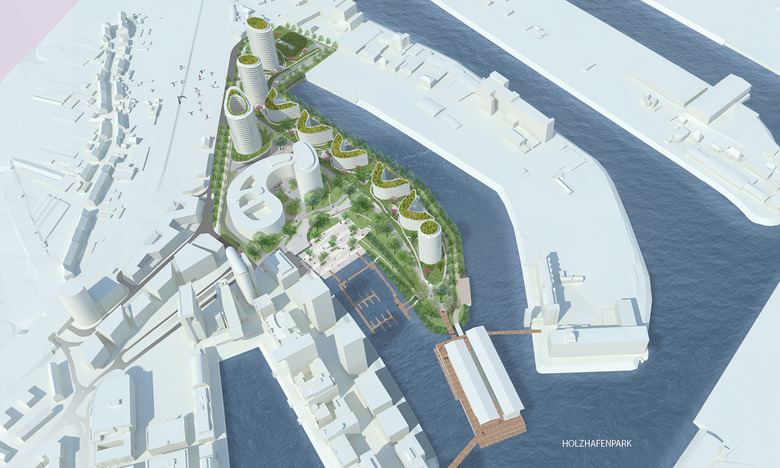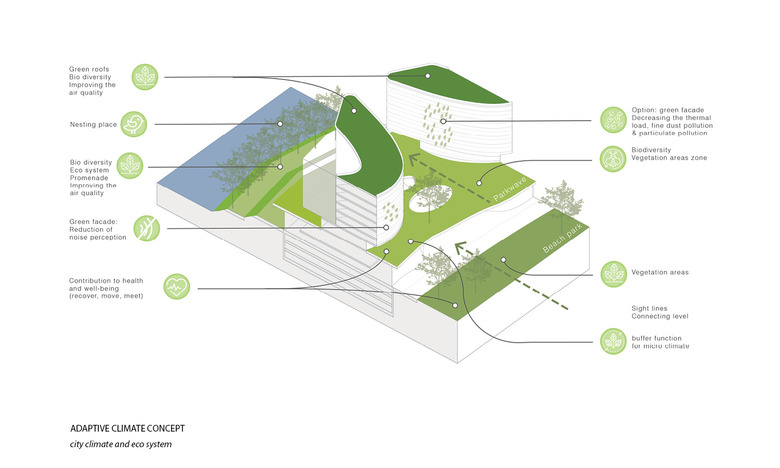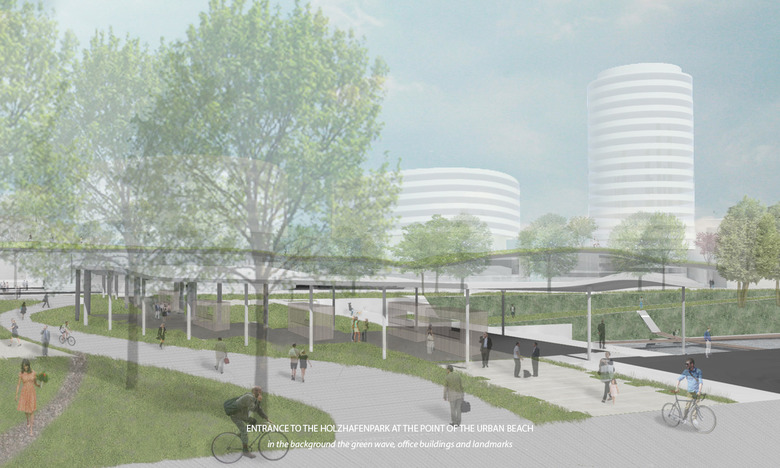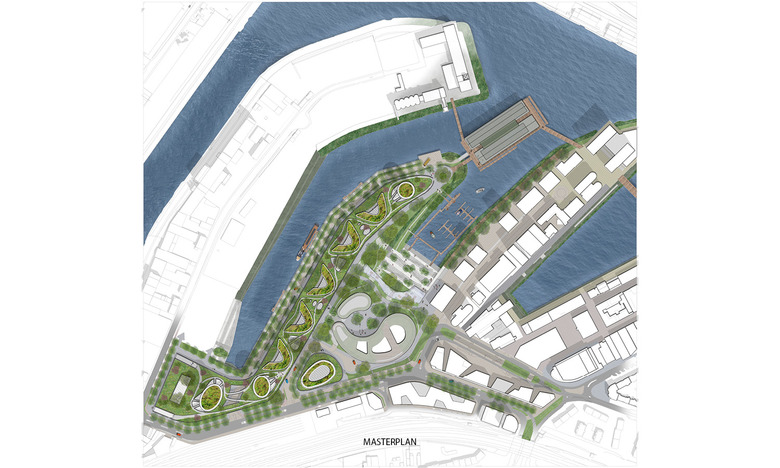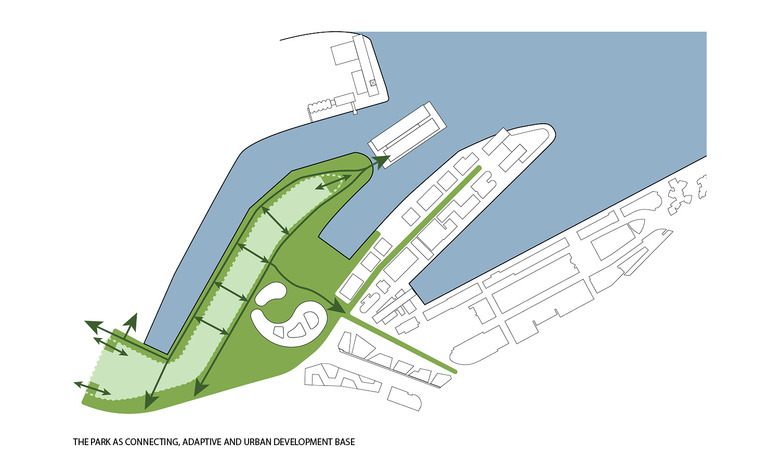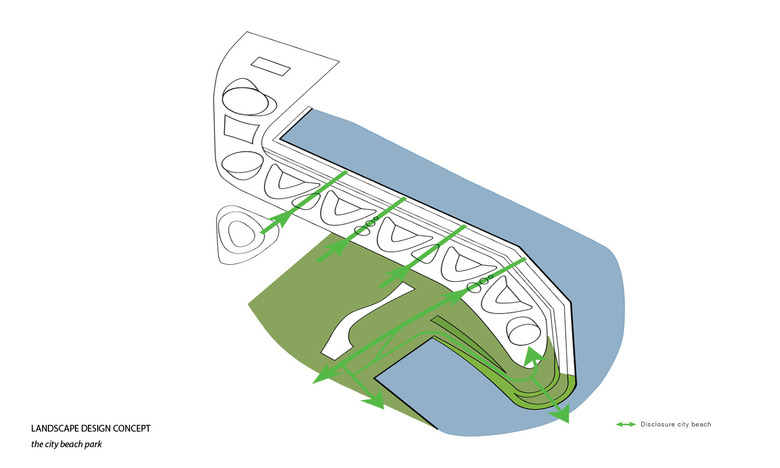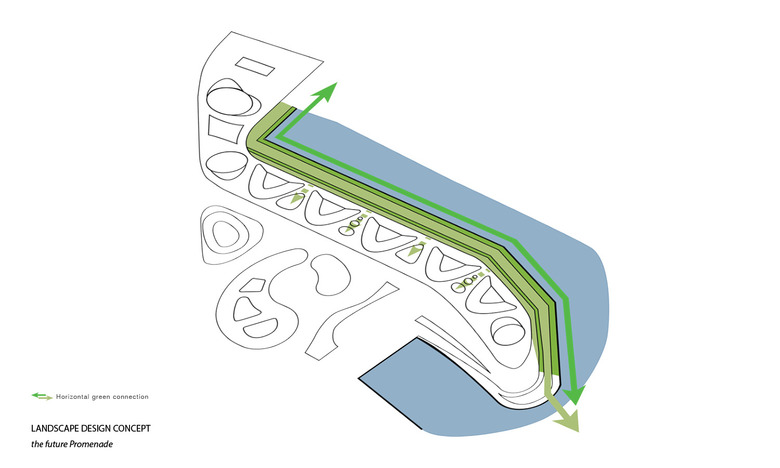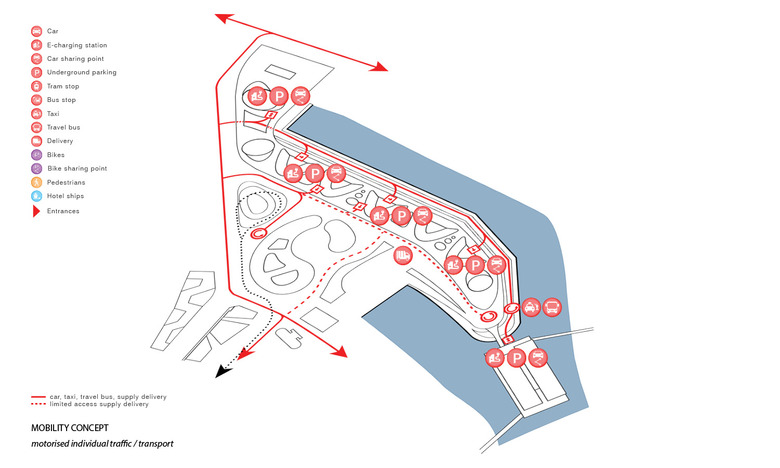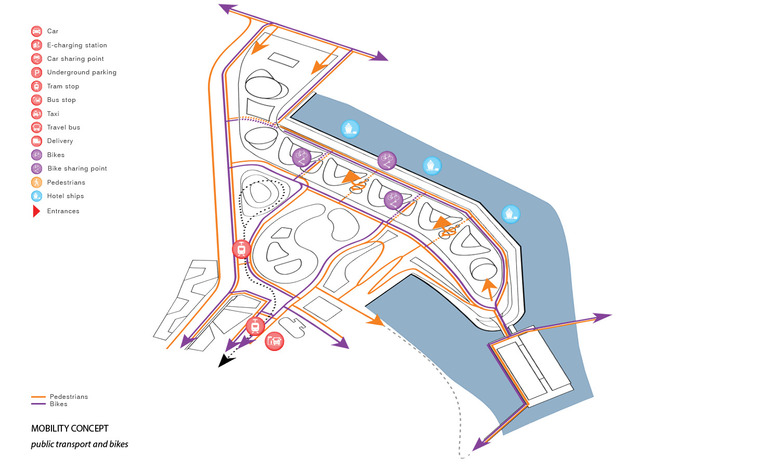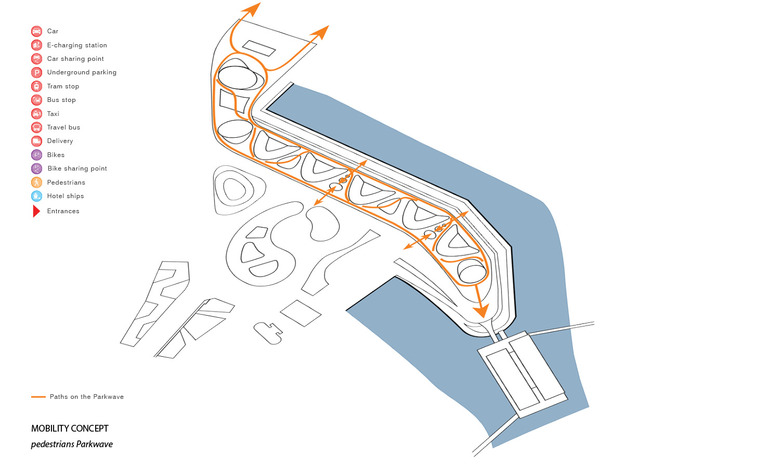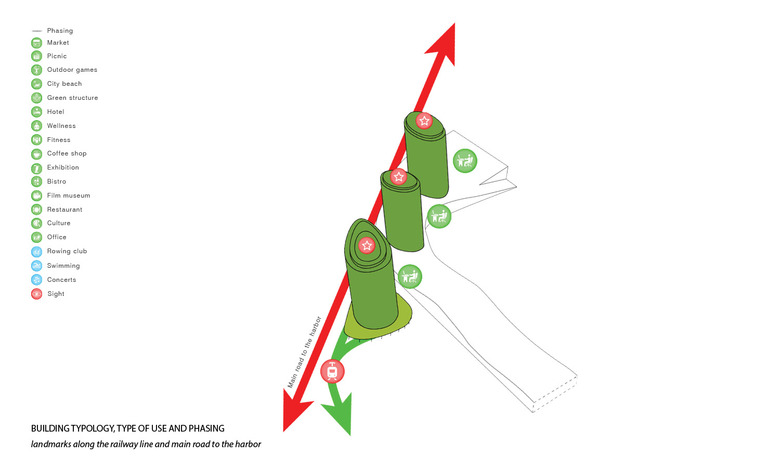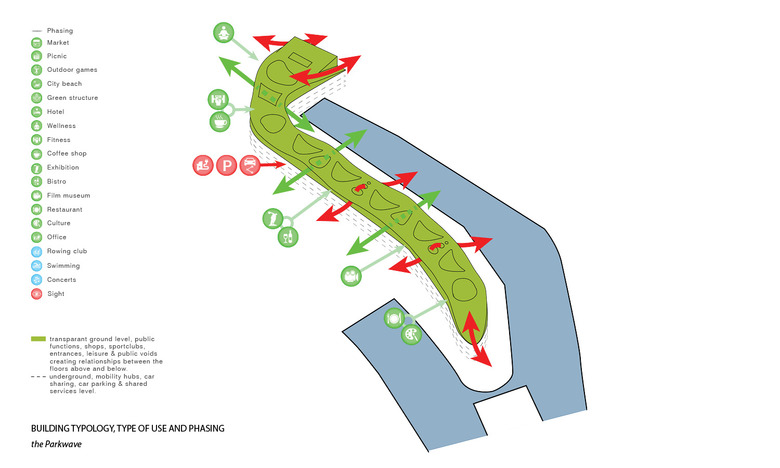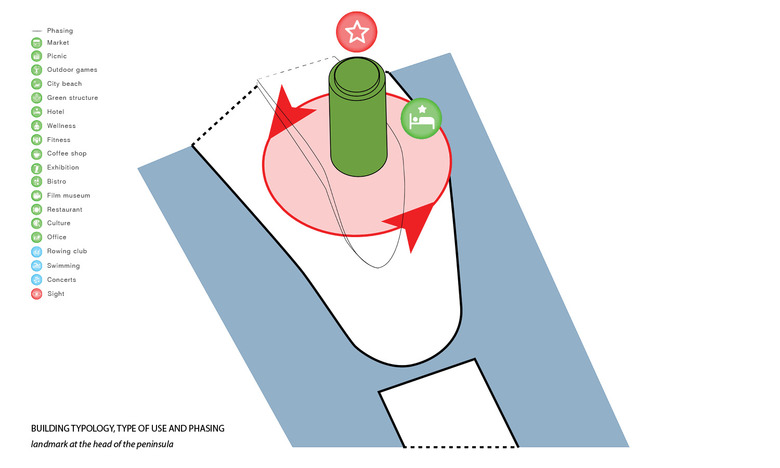Düsseldorf Medienhafen
Torna alla Lista di Progetti- Parchi + Spazi aperti
- Architettura paesaggistica
- Piano regolatore
- Sviluppo urbanistico
- Studi urbanistici
- Research
- Landscape Architect
- Burobol
The competition entry for Düsseldorf harbor peninsula is a sustainable urban concept for a regenerative, adaptive and resilient city. The design is based on a blue-green infrastructure which enhances the urban quality, the social life of the city and the biodiversity in the city.
Competition Düsseldorf Medienhafen
Ecological Urban Planning Concept
The port was originally alluvial and later arable land on the Rhine banks prior to the use of the port. With the development of the Medien Hafen at the beginning of the 90s of the last century the industrial port usage was relocated over the years always further to the west post and made space for the service sector, as well as leisure facilities, hotels and gastronomy. The development of the Düsseldorf Medien Hafen on the peninsula of Kesselstraße offers the chance to return a piece of landscape to the city and its inhabitants.
The urban planning concept of the peninsula Kesselstraße in its particular location between the media port and the industrial port will have both in city spatial and functional terms a unique function in the urban context. The urban development concept for the peninsula Kesselstraße must be designed facing a rapidly changing future and the green, compact and diverse city of tomorrow. A concept that is adaptable and creates attractive habitats for various uses, both during the day and in the evening in every season. To achieve this, it requires a strategy, not posed as in classical urban development first and foremost by the arrangement of building volume, but that creates a resilient, adaptive basis for the development of the area and networking in the context. At the same time a permanent identification hotspot for people and businesses must be created on the peninsula. A landscape park can achieve this. A landscape park as a site for new businesses, for people working in the enlarged media port, tourists, who arrive or stay there, as well as for local residents and water sports enthusiasts. A park as an attractive living environment where people work, meet friends and colleagues, do sports, listen to concerts, and visit exhibitions or spend the lunch break at the water. In this concept the peninsula of Kessel street is being developed as Holzhafen Park.
Mobility
An innovative, adaptive and sustainable mobility concept is necessary to allow this landscape park, which significantly reduces road traffic in the foreseeable future. On the other hand, mobility for every individual, but also the whole society is important; meaning, a city's overall mobility strategy must be well connected, very attractive and versatile, that rethinking is easy and an added value becomes apparent. The mobility concept for the Holzhafen Park connects the parent system with a dense pedestrian and bicycle trail network on several levels which is on all sides connected with existing networks. Attractively designed car and bicycle sharingpoints are easy to find, and arranged centrally under the waved roof of the park. The embankment along the dock B is the main access for the motorized private transport, taxis, and suppliers designed as an attractive Promenade. Here motorists find the access to the mobility level for rental and sharing cars, as well as to the related underground car park, which extends in a north south direction along the Green promenade . Normally the Holzhafen Park is characterized by pedestrians and cyclists. Emergency access for support services is possible as well as in fixed time frames for delivery traffic. In this way, areas for motorized traffic in favor of green spaces can be limited. At the interface between Medien Hafen and Holzhafen Park, an new, urban, public space is created, where a transparent pergola acts as a filter to the Urban Beach. Here people find the ice or Curry sausage seller as well as the espresso bar and the fresh food seller.
Landscape Architecture Concept
The Holzhafen Park is characterized by four elements which all contribute to the quality of life in the new area and stimulates to have a rest, to meet, to move, and motivated to pursue his work:
• the Urban Beach
• the Beach Park
• the connecting Park Wave
• the Promenade
The Urban Beach
In midsummer early risers enjoy the tranquility of this place in the morning, before at lunch time or in the evening city residents and people who work in the harbour meet each other on the spacious stairs or jump from the boardwalks in the swimming area. During the cooler seasons, the stairs still invite to linger and at the same time connect the different routes in the Medien Hafen.
The Beach Park
The park links the context, the urban beach and the Park Wave, with the tip of the peninsula in the north and the courtyard of the existing office building in the south-east of the site. Walkers enjoy under old, existing trees the view on the goings-on in the port, sports and fitness enthusiasts find place for outdoor training and others recover from a stressful meeting overlooking the water or directly below from one of the wooden walkways
The Park Wave
Like a green, floating canopy the Park Wave connects both in horizontal and vertical direction all ways, functions and uses, as well as public and semi-public spaces. With an inviting stairway in the north, which can be used for outdoor activities, the Park Wave links the north of the peninsula with the south of the harbour basin B and allows the continuation of the Park in the future there. Building volumes are punched through the Park wave. Large openings in the roof mark the way connections in east-west direction and let light penetrate down to the level of mobility, where shared services and E charging stations are located. Along these daylight flooded passages the entrances to the different uses can be found. Light, transparent façades enclose the spaces under the green, waved roof. The result is a highly attractive, dynamic place that invites you to meet, to exchange, to work together and to remain. The Park Wave is the flagship of the Holzhafen Park, the lively engine that combines and links in spatial, functional and social ways during the day and also in the evening hours. People work here in modern, open offices, and co-working spaces, meet at noon in bistros and cafés, as well as in the evening in restaurants. Also people can use the roof garden for a run or visited a wellness or fitness studio on the ground level. But also music and exhibition lovers can find here attractive offers.
The construction structure of the Park Wave can be manufactured from cross laminated timber and refers with the material wood to the previous function of the port and characterizes the attractive, vibrant and inspiring atmosphere.
The Promenade
Tourists on the hotel ships arrive at a unique location in Düsseldorf. They will be welcomed by a tree-lined promenade on two levels, which are connected by long ramps and spacious stairways. The transparent facades under the Park Wave, as well as the atriums and green facades of the new office buildings dominate the urban, cosmopolitan atmosphere. The walkers along the promenade can rest on stepped seat levels between the landing stages and watch the going-on of the port.
Building Typologies
The three high-rise buildings along the railway line characterize the skyline of the Holzhafen Park in the south and blend the new urban configuration into the existing and overall picture of the towers in the Media Port. The high-rise and pergola in the south-east welcome at an attractive location the commuter daily leaving the tram or bus at this stop. The northern tip of the port peninsula is marked by a free-standing landmark. On the one hand the tower marks the location, on the other hand it fits its position and moderate hight in the overall picture and respects the importance of the tower of the former mill in the skyline. The contour of the building volumes under or above the Park Wave are been designed in a way that provides on both sides high-quality public spaces, that multiple visual relationships arise and the character of the park can flow through east-west direction.
The new Holzhafen Park marks the site and gives it an own high-quality identity. It connects in north-south as east-west direction with the Media Port. The Holzhafen Park is characterized by a spirit of optimism and an inspiring liveliness. It is the new attraction-hotspot in the enlarged Media Port for established businesses, start-ups, or visitors and residents.
How and with what measures the adaptive concept could be realized, tell the schemes of the different topics, such as mobility, landscape design, ecosystem and water management.
